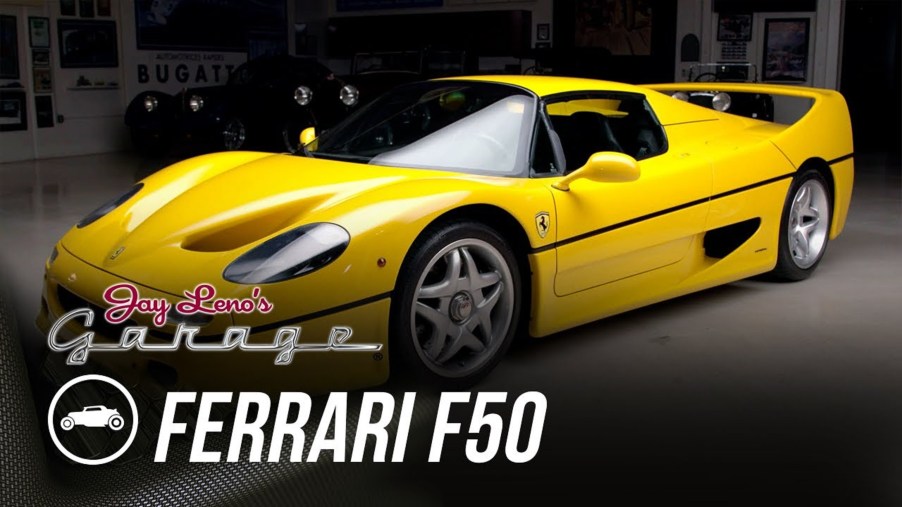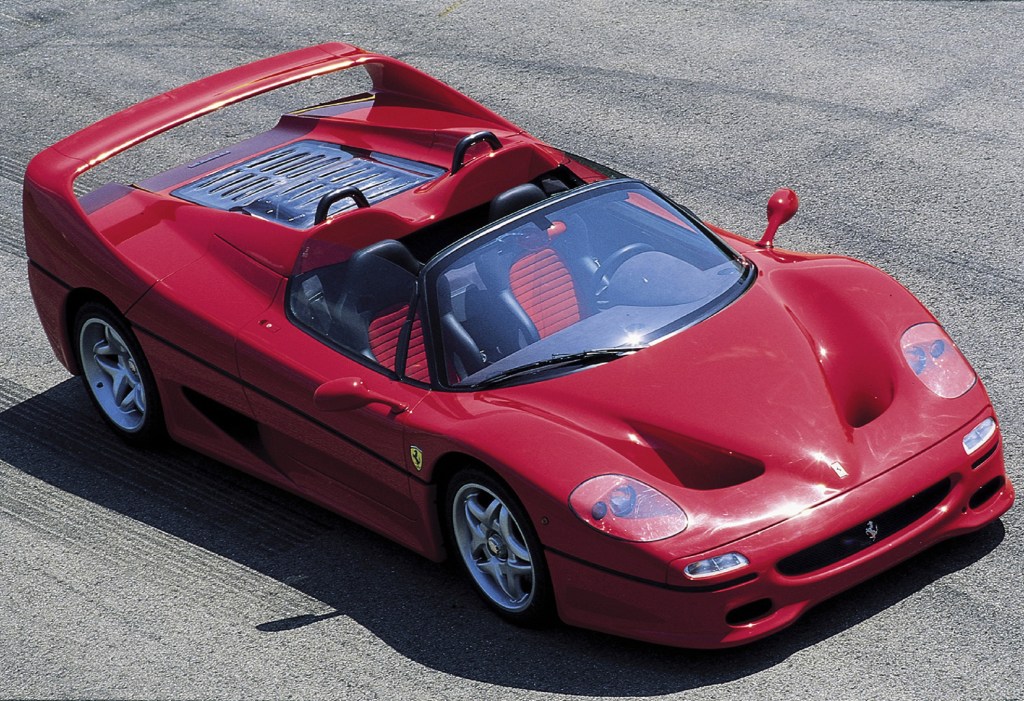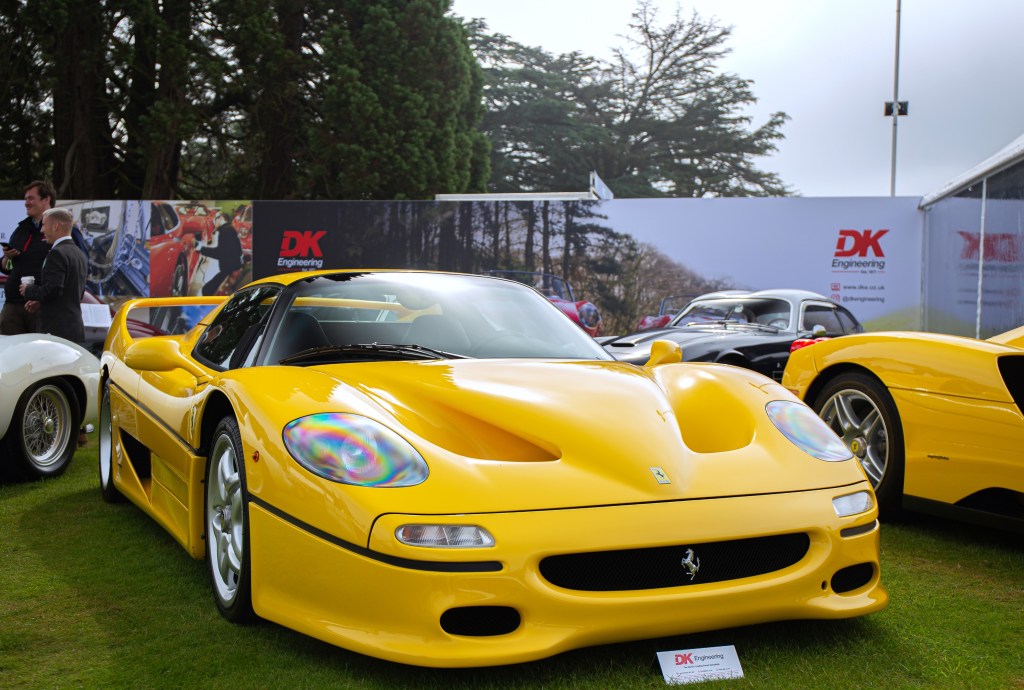
A Rare Yellow Ferrari F50 Is Anything but Mellow for Jay Leno
Jay Leno in a yellow Ferrari F50 highlights:
- Renowned Ferrari collector David Lee brought two F50s, including a rare yellow one, to Jay Leno’s garage
- The Ferrari F50 is arguably less loved than the other Ferrari halo supercars, despite its genuine Formula One technology
- As a turning point between pared-down manual V12 cars to tech-heavy turbocharged models, the mid-engine F50 is an enthralling car in its own right
It’s hard to believe, but not every Ferrari has immediate star power—and that includes the classic ones. Admittedly, some unloved Ferraris get no respect because they (gasp!) aren’t that fun to drive. Others, though, have the misfortune to live in another car’s shadow. Depending on who you ask, the Ferrari F50 falls into the latter category. But the naysayers might think differently after watching Jay Leno nerd out over a special yellow F50.
The Ferrari F50 is a classic supercar that’s really built like an F1 race car

| 1995-1997 Ferrari F50 | |
| Engine | 4.7-liter ‘F130B’ V12 |
| Horsepower | 512 hp |
| Torque | 347 lb-ft |
| Transmission | Six-speed manual |
| Dry weight | 2712 lbs |
| 0-60 mph time | 3.8 seconds |
Hearing that a road car has racing tech often amounts to marketing hype or maybe one or two minor parts. That’s not the case with the Ferrari F50. When we say that it’s one of the closest things to a 1990s F1 car for the road, that’s not hyperbole.
For one, the F50’s mid-mounted 4.7-liter V12 is genuinely derived from a Ferrari F1 engine, Hagerty explains. Furthermore, it’s a stressed member of the carbon-fiber chassis, mounted in the middle via metal subframes. That’s not great for NVH, but it’s excellent for handling and rigidity. Oh, and speaking of carbon fiber, the F50 is the first Ferrari road car with a carbon-fiber chassis.
However, the F1 connections go further than just the engine and tub. The Ferrari F50 doesn’t have power steering, airbags, or even ABS. Because, you know, race car. It does have electronically-controlled shocks, though, and they’re mounted horizontally, again, because race car. But there’s one more F1 touch that, while normal in the mid-90s, is decidedly vintage today: a manual transmission. And it’s a gated one at that.
As alluded to earlier, the Ferrari F50 isn’t a great road car. The chassis design makes for a harsh ride, and it means some maintenance tasks involve splitting the car in half. And it’s not exactly luxurious inside. The racing-derived features are also what make it a blast to drive, though, which we’ll get to shortly. And it has a Targa roof to hear that V12 better.
But that also means discussing the F50’s, um, ‘interesting’ relationship with the brand’s fanbase.
The F50 is rare even among classic Ferrari supercars—especially if it’s yellow

Among the ‘flagship’ Ferrari halo supercars—288 GTO, F40, F50, Enzo, and LaFerrari—the F50 is the second rarest. Only 349 F50s exist, making it even rarer than the car named after the brand’s founder. Ferrari made almost four times as many F40s as F50s, and the F40 is arguably more widely beloved today. And only 31 of those 349 F50s were painted yellow from the factory.
That explains why a yellow F50 is special, but why is the car itself so rare and, dare I say, unpopular? Well, there’s no single overwhelming factor, but there are several possible reasons.
Firstly, the F40 was the last car released with Enzo Ferrari at the helm. And it was a genuine rally homologation special, while the F50 ‘merely’ borrowed F1 tech. Yes, that sounds academic, but then, we’re talking classic Ferraris here. ‘Academic’ doesn’t begin to describe some of the market’s fastidiousness.
In addition, not only did the F50 debut shortly after Enzo Ferrari’s death, but it did so alongside the McLaren F1. And while the F50’s 202-mph top speed is still impressive, the F1 remains the fastest naturally-aspirated road car ever. Also, the F1 has three seats, to the Ferrari’s two, and it’s a far more civilized car.
Furthermore, even though the F50 was designed by long-time Ferrari collaborator Pininfarina, its styling turned many collectors off, Hagerty notes. And when some US collectors—who had to own several Ferraris already—did step up, they couldn’t buy it outright. Instead, they had to lease it for two years, starting with a $240,000 deposit, Road & Track says. It was designed to prevent F50 flippers—much like Ford did with the GT—but it didn’t endear potential buyers.
Jay Leno and collector David Lee are serenaded by the V12’s siren shriek
It’s these types of restrictions that keep Jay Leno from owning any Ferraris; at least, any modern ones. But that doesn’t mean he doesn’t appreciate the brand’s achievements. And he was very appreciative of notable Ferrari collector David Lee bringing over his red and yellow F50s.
While the F50 has a removable roof, removing it is fiendishly complicated, so Leno and Lee drove with it on. Fortunately, because the engine is right behind you, the exhaust note fills the sparse cabin quickly. And while the V12 isn’t as torquey as the F40’s twin-turbo V8, it belts the iconic classic Ferrari 12-cylinder song. “It’s what a Ferrari’s all about,” Jay Leno notes. But it really wakes up above 3500 rpm.
“You can’t beat the V12 sound.”
Jay Leno
The F50 isn’t just a Ferrari, though: it’s also a transition point. It’s Ferrari’s first carbon-fiber road chassis, but also its last halo car with a stick-shift and a naturally-aspirated engine. The carbon-fiber Enzo has an N/A V12, but with a single-clutch automated manual. And the LaFerrari is a dual-clutch hybrid.
Plus, no modern Ferrari has a manual, let alone a gated one. There’s no mid-engine V12 Ferrari, either. And the only V12 Ferrari left, the front-engine 812, is likely the brand’s last NA car, too.
As such, the rear-wheel-drive, mid-engine, V12-powered Ferrari F50 is kind of “the best of both worlds,” Leno says. It has the classic Ferrari sound and feel but with the layout of a newer one. When you put it that way, it’s easy to see why Lee claims that F50 owners “love their cars.” And perhaps, why some of us enthusiasts could appreciate it more.
Whether red, yellow, or some other shade, a Ferrari F50 is more than almost all of us can afford
There’s one place where the Ferrari F50 is already appreciated, though, and that’s the classic car market. Due to its low production volume, the F50 typically out-values even rare F40 models.
Although red is the most common F50 color, its significance to Prancing Horse fans means these cars are often the most valuable. Interestingly, though, the yellow ones are even more historically significant. According to David Lee, yellow was the original Ferrari racing color.
But even a ‘cheap’ Ferrari F50 is worth more than most houses. A fair-condition example typically goes for $2.65 million, Hagerty reports. And pristine ones, with original paint that lets the carbon weave show, are worth over $4 million.
So, even if the F50 doesn’t always get as much respect as the F40 or Enzo, something tells me owners aren’t too bummed about it.
Follow more updates from MotorBiscuit on our Facebook page.


